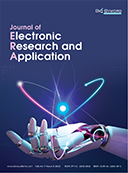Abstract
As modern weapons and equipment undergo increasing levels of informatization, intelligence, and networking, the topology and traffic characteristics of battlefield data networks built with tactical data links are becoming progressively complex. In this paper, we employ a traffic matrix to model the tactical data link network. We propose a method that utilizes the Maximum Variance Unfolding (MVU) algorithm to conduct nonlinear dimensionality reduction analysis on high-dimensional open network traffic matrix datasets. This approach introduces novel ideas and methods for future applications, including traffic prediction and anomaly analysis in real battlefield network environments.
References
Papagiannaki N, Taft N, Zhang Z, et al., 2003, 22nd Annual Joint Conference of the IEEE Computer and Communications Societies, March 30–April 3, 2003: Long-Term Forecasting of Internet Backbone Traffic: Observations and Initial Models. IEEE INFOCOM 2003, San Francisco, vol 2, 1178–1188. https://doi.org/10.1109/INFCOM.2003.1208954
Zhang Y, Roughan M, Lund C, et al., 2003, SIGCOMM ‘03: Applications, Technologies, Architectures, and Protocols for Computer Communications, August 25–29, 2003: An Information-Theoretic Approach to Traffic Matrix Estimation. ACM SIGCOMM, Karlsruhe, 301–312. https://doi.org/10.1145/863955.863990
Soule A, Nucci A, Cruz R, et al., 2004, How to Identify and Estimate the Largest Traffic Matrix Elements in a Dynamic Environment. ACM SIGMETRICS Performance Evaluation Review, 32(1): 73–84. https://doi.org/10.1145/1012888.1005698
Medina A, Taft N, Salamatian K, et al., 2002, Traffic Matrix Estimation: Existing Techniques and New Directions. ACM SIGCOMM Computer Communication Review, 32(4): 161–174. https://doi.org/10.1145/964725.633041
Crovella M, Kolaczyk E, 2003, 22nd Annual Joint Conference of the IEEE Computer and Communications Societies, March 30–April 3, 2003: Graph Wavelets for Spatial Traffic Analysis. IEEE INFOCOM 2003, San Francisco, vol 3, 1848–1857. https://doi.org/10.1109/INFCOM.2003.1209207
Tune P, Roughan M, 2013, Internet Traffic Matrices: A Primer, in Recent Advances in Networking, ACM SIGCOMM eBook, vol 1, 108–163. https://sigcomm.org/education/ebook/SIGCOMMeBook2013v1_chapter3.pdf
Lakhina A, Papagiannaki K, Crovella M, et al., 2004, SIGMETRICS ‘04/Performance ‘04: Proceedings of the Joint International Conference on Measurement and Modeling of Computer Systems, June 10–14, 2004: Structural Analysis of Network Traffic Flows. ACM SIGMETRICS, New York, 61–72. https://doi.org/10.1145/1005686.1005697
Weinberger KQ, Packer B, Saul LK, 2005, Proceedings of the 10th International Workshop on Artificial Intelligence and Statistics, January 6–8, 2005: Nonlinear Dimensionality Reduction by Semidefinite Programming and Kernel Matrix Factorization. Society for Artificial Intelligence and Statistics, Barbados, 381–388.
Weinberger KQ, Saul LK, 2004, Proceedings of the 2004 IEEE Computer Society Conference on Computer Vision and Pattern Recognition, June 27–July 2, 2004: Unsupervised Learning of Image Manifolds by Semidefinite Programming. IEEE-CSDATC, Washington, vol 2, II-988–II-995. https://doi.org/10.1109/CVPR.2004.1315272
Weinberger KQ, Saul LK, 2006, AAAI ’06: Proceedings of the 21st National Conference on Artificial Intelligence, July 16–20, 2006: An Introduction to Nonlinear Dimensionality Reduction by Maximum Variance Unfolding. AAAI, Boston, vol 2, 1683–1686.
Weinberger KQ, Sha F, Saul LK, 2004, Proceedings of the 21st International Conference on Machine Learning, July 4–8, 2004: Learning a Kernel Matrix for Nonlinear Dimensionality Reduction. ACM, Banff, 839–846.
Tenenbaum JB, de Silva V, Langford LC, 2000, A Global Geometric Framework for Nonlinear Dimensionality Reduction. Science, 290(5500): 2319–2323. https://doi.org/10.1126/science.290.5500.2319
